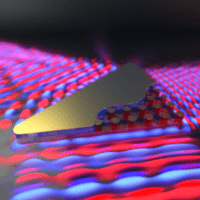News
New zero-index material made of silicon pillar arrays embedded in a polymer matrix and clad in gold film creates a constant phase of light, which stretches out in infinitely long wavelengths. (Illustration by Credit: Peter Allen/Harvard SEAS)
Electrons are so 20th century. In the 21st century, photonic devices, which use light to transport large amounts of information quickly, will enhance or even replace the electronic devices that are ubiquitous in our lives today. But there’s a step needed before optical connections can be integrated into telecommunications systems and computers: researchers need to make it easier to manipulate light at the nanoscale.
Researchers at the Harvard John A. Paulson School of Engineering and Applied Sciences (SEAS) have done just that, designing the first on-chip metamaterial with a refractive index of zero, meaning that the phase of light can travel infinitely fast.
This new metamaterial was developed in the lab of Eric Mazur, the Balkanski Professor of Physics and Applied Physics and Area Dean for Applied Physics at SEAS, and is described in the journal Nature Photonics.
“Light doesn’t typically like to be squeezed or manipulated but this metamaterial permits you to manipulate light from one chip to another, to squeeze, bend, twist and reduce diameter of a beam from the macroscale to the nanoscale,” said Mazur. “It’s a remarkable new way to manipulate light.”
Although this infinitely high velocity sounds like it breaks the rule of relativity, it doesn’t. Nothing in the universe travels faster than light carrying information — Einstein is still right about that. But light has another speed, measured by how fast the crests of a wavelength move, known as phase velocity. This speed of light increases or decreases depending on the material it’s moving through.
When light passes through water, for example, its phase velocity is reduced as its wavelengths get squished together. Once it exits the water, its phase velocity increases again as its wavelength elongates. How much the crests of a light wave slow down in a material is expressed as a ratio called the refraction index — the higher the index, the more the material interferes with the propagation of the wave crests of light. Water, for example, has a refraction index of about 1.3.
When the refraction index is reduced to zero, really weird and interesting things start to happen.
In a zero-index material, there is no phase advance, meaning light no longer behaves as a moving wave, traveling through space in a series of crests and troughs. Instead, the zero-index material creates a constant phase — all crests or all troughs — stretching out in infinitely long wavelengths. The crests and troughs oscillate only as a variable of time, not space.
This uniform phase allows the light to be stretched or squished, twisted or turned, without losing energy. A zero-index material that fits on a chip could have exciting applications, especially in the world of quantum computing.
“Integrated photonic circuits are hampered by weak and inefficient optical energy confinement in standard silicon waveguides,” said Yang Li, a postdoctoral fellow in the Mazur Group and first author on the paper. “This zero-index metamaterial offers a solution for the confinement of electromagnetic energy in different waveguide configurations because its high internal phase velocity produces full transmission, regardless of how the material is configured.”
The metamaterial consists of silicon pillar arrays embedded in a polymer matrix and clad in gold film. It can couple to silicon waveguides to interface with standard integrated photonic components and chips.
“In quantum optics, the lack of phase advance would allow quantum emitters in a zero-index cavity or waveguide to emit photons which are always in phase with one another,” said Philip Munoz, a graduate student in the Mazur lab and co-author on the paper. “It could also improve entanglement between quantum bits, as incoming waves of light are effectively spread out and infinitely long, enabling even distant particles to be entangled.”
“This on-chip metamaterial opens the door to exploring the physics of zero index and its applications in integrated optics,” said Mazur.
The paper was co-authored by Shota Kita, Orad Reshef, Daryl I. Vulis, Mei Yin and Marko Loncar, the Tiantsai Lin Professor of Electrical Engineering.
Cutting-edge science delivered direct to your inbox.
Join the Harvard SEAS mailing list.
Scientist Profiles
Eric Mazur
Balkanski Professor of Physics and Applied Physics
Press Contact
Leah Burrows | 617-496-1351 | lburrows@seas.harvard.edu

